Übersetzung
claudia_aden@web.de
ian.erik.stewart@googlemail.com
2017/22/5



Übersetzung
claudia_aden@web.de
ian.erik.stewart@googlemail.com
2017/22/5
Dieses Kleingedruckte dient einzig und allein dem Zweck, dieses Buch stärker einem richtigen Buch ähneln zu lassen. Bei gedruckten Büchern findet man gewöhnlich auf der ersten oder zweiten Seite eine lange Passage winzig klein gedruckten Textes, gefolgt von Begriffen wie © 2013. Alle Rechte vorbehalten. Herr/Frau Mustermann. Gedruckt in den Vereinigten Staaten von Amerika. Manchmal ergeht sich der Herausgeber daraufhin in Prosa, um potenzielle Urheberrechtspiraten abzuschrecken. Dieses Buch darf ohne schriftliche Genehmigung in keinster Weise verwendet oder reproduziert werden – auch nicht auszugsweise. Hierauf folgen gewöhnlich eine oder zwei Zeilen zum Herausgeber sowie eine Reihe von Zahlen.
Für nähere Informationen kontaktieren Sie bitte JasperCollins Publishers, 99 St Marks Pl New York, NY, 94105
12 13 14 15 16 LP/SSRH 10 9 8 7 6 5 4 3 2 1
Aber im Ernst – alles, was Sie wissen müssen, ist, dass dieses Werk unter einer
Creative Commons BY-NC-Lizenz geteilt wurde. Das bedeutet, dass Sie es unter Angabe der Quelle zu nicht kommerziellen Zwecken frei teilen und adaptieren können.
Künstlerische Leitung: Ali Almossawi, Illustration: Alejandro Giraldo, Übersetzung: Claudia Aden und Ian Erik Stewart.
„Ich liebe dieses illustrierte Buch der schlechten Argumente.
Ein mängelfreies Kompendium der Mängel.“
„Eine wunderbar leicht verdauliche Zusammenfassung argumentativer Fallstricke und Techniken. Ich kann mir keinen besseren Weg zum Erlernen oder Auffrischen dieser grundlegenden Prinzipien des logischen Diskurses vorstellen. Ein herrliches kleines Buch.“



Dieses Buch richtet sich an Neulinge auf dem Gebiet der logischen Argumentation, insbesondere an solche, die – um mit Pascals Worten zu sprechen – so geschaffen sind, dass sie Sachverhalte am besten anhand visueller Darstellungen begreifen. Ich habe eine kleine Auswahl häufiger Fehlschlüsse zusammengestellt, mithilfe eingängiger Illustrationen visualisiert und um zahlreiche Beispiele ergänzt. Ich hoffe, die Lektüre dieses Buches wird den Leserinnen und Lesern einige der häufigsten logischen Fehlschlüsse nahebringen, sodass sie diese in der Praxis erkennen und vermeiden können.

Logik und logische Fehlschlüsse werden in der einschlägigen Literatur umfassend und ausgiebig behandelt. Die Neuartigkeit des vorliegenden Buches liegt in der Verwendung von Illustrationen zur Erläuterung einer kleinen Auswahl häufiger Fehlschlüsse, die sich oft in unseren gegen-wärtigen Diskurs einschleichen.
Die Inspirationen für die Illustrationen lieferten zum Teil Allegorien wie Orwells Farm der Tiere und teils auch humoristischer Nonsens in der Literatur, wie er in den Geschichten und Gedichten Lewis Carrolls vorkommt. Anders als in diesen Werken werden die Bilder jedoch nicht durch einen Erzählstrang zusammengehalten; es handelt sich vielmehr um voneinander unabhängige Szenen, denen nur Stil und Thema gemein sind. So können sie besser adaptiert und wieder-verwendet werden. Jeder Fehlschluss wird auf nur einer Seite erläutert; die Knappheit des Schreibstils ist somit gewollt.
Die Beschäftigung mit Negativbeispielen ist tatsächlich lohnenswert. So schreibt Stephen King in seinem Buch Das Leben und das Schreiben: „Am deutlichsten sieht man, wie man es nicht machen soll, wenn man schlechte Bücher liest.“ Die Erfahrung, ein besonders schlechtes Buch zu lesen, beschreibt er „als literarische Pockenimpfung“ [King2]. Der Mathematiker George Pólya soll einmal über das Lehren des Faches gesagt haben, man müsse die Mathematik dazu nicht nur gut verstehen; man müsse auch verstehen, sie misszuverstehen [Pólya]. Das vorliegende Buch beschäftigt sich primär mit Dingen, die man beim Argumentieren nicht tun sollte.1
* * * *
1 Für eine Betrachtung des Gegenteils, siehe T. Edward Damers Buch über das fehlerhafte Argumentieren.
Vor vielen Jahren habe ich meine Zeit u. a. damit verbracht, Softwarespezifikationen zu verfassen. Ich habe dazu Prädikatenlogik erster Stufe verwendet. Sie bot mir eine interessante Möglichkeit, Beweise über Invarianten zu führen und diese nicht in der herkömmlichen Notation – auf Englisch – sondern mithilfe von diskreter Mathematik darzulegen. Das brachte Präzision statt potenzieller Ambiguität und Stringenz statt Verallgemeinerungen.
Zur selben Zeit habe ich einige Bücher über moderne und mittelalterliche Aussagenlogik studiert, darunter auch Robert Gulas A Handbook of Logical Fallacies. Gulas Buch hat mich an einige Heuristiken erinnert, die ich ein Jahrzehnt zuvor in ein Notizbuch zum Thema Argumentieren hineingekritzelt hatte. Ich hatte im Laufe mehrerer Jahre, die ich mit Debatten in Online-Foren verbracht hatte, eine Liste zusammengetragen mit Punkten wie: „Versuche, keine generellen Behauptungen aufzustellen.“ Heute scheint mir das offensichtlich, aber für einen Schuljungen war es eine spannende Erkenntnis.
Es wurde schnell klar, dass das Formalisieren von Argumenten nützliche Vorteile mit sich brachte, wie Klarheit im Denken und im Ausdruck, Objektivität und größeres Selbstvertrauen. Die Fähigkeit, Argumente zu analysieren, gab einem außerdem einen Maßstab an die Hand, um zu beurteilen, wann man sich aus Diskussionen zurückziehen sollte, die höchstwahrscheinlich vergeblich sein würden.
Themen und Ereignisse, die unser Leben und die Gesellschaft, in der wir leben, beeinflussen – wie Bürgerrechtsfragen oder Präsidentschaftswahlen – führen gewöhnlich dazu, dass Menschen
politische Programme und Überzeugungen debattieren. Wenn man sich diese Debatten anschaut, merkt man, dass ein beträchtlicher Teil davon an einem Mangel an guter Argumentation krankt. Es gibt einige Werke zur Logik, die dem Leser Werkzeuge und Paradigmen an die Hand geben, die gutes Argumentieren fördern und somit zu konstruktiveren Debatten führen.
Überzeugungskraft kann eine Folge logischer Argumentation sein, muss sie aber nicht. Sie kann auch anderen Ursprungs sein und es ist hilfreich, sich dies bewusst zu machen. Rhetorik steht wahrscheinlich ganz oben auf dieser Liste; man denke an Grundsätze wie das Sparsamkeitsprinzip oder die Beweispflicht und wem sie obliegt. Interessierte Leserinnen und Leser seien hier auf die umfangreiche Literatur zu diesem Thema verwiesen.
Abschließend sei darauf hingewiesen, dass die Regeln der Logik keine Naturgesetze sind und dass sie das menschliche Schlussfolgern nicht erschöpfend abbilden. Marvin Minsky schreibt, dass sich der gesunde Menschenverstand – ebenso wie Analogien – nur schwer über logische Prinzipien erklären lässt und fügt hinzu, dass „Logik genauso wenig erklärt, wie wir denken, wie Grammatik erklärt, wie wir sprechen“ [Minsky]. Logik schafft keine neuen Wahrheiten, erlaubt es uns aber, die Widerspruchsfreiheit und Kohärenz bereits bestehender Gedankengänge zu überprüfen. Genau dies macht sie zu so einem effektiven Werkzeug für die Analyse und das Kommunizieren von Ideen und Argumenten.
– A.A., San Francisco, Juli 2013

Das oberste Gebot ist, dass man sich selbst nicht täuschen darf; dabei ist man selbst die Person, die sich am einfachsten täuschen lässt.
—Richard P. Feynman
Beim Berufen auf die Folgen argumentiert man für oder gegen die Gültigkeit einer Aussage, indem man sich auf die Folgen das Akzeptierens oder Ablehnens derselben beruft. Nur weil eine Aussage zu einem ungünstigen Ergebnis führt, bedeutet dies aber nicht, dass sie falsch ist. Ebenso ist eine Aussage, die wünschenswerte Folgen hat, nicht automatisch wahr. David Hackett Fisher drückte es so aus: „Man kann nicht folgern, dass sich eine Eigenschaft, die einer Folge zu eigen ist, auf deren Ursache übertragen lässt.“
Falls es sich um gute Folgen handelt, könnte ein Argument an die Hoffnungen eines Publikums appellieren; dies kann manchmal die Form von Wunschdenken annehmen. Falls es sich um schlechte Folgen handelt, könnte ein Argument stattdessen an die Ängste eines Publikums appellieren. Betrachten wir Dostojewskis Aussage: „Wenn es keinen Gott gibt, ist alles erlaubt.“ Von Diskussionen über objektive Moral einmal abgesehen, sagt dieses Berufen auf die augenscheinlich düsteren Folgen einer „gottlosen“ Welt jedoch nichts darüber aus, ob die Antezedenz wahr ist.
Man sollte dabei nicht vergessen, dass solche Argumente nur dann Fehlschlüsse darstellen, wenn sie sich auf Aussagen mit objektivem Wahrheitsgehalt beziehen, und nicht, wenn es um Entschei-dungen oder politische Programme geht [Curtis], z. B. wenn sich ein Politiker gegen eine Steuererhöhung ausspricht, da er Angst hat, dass diese das Leben seiner Wähler negativ beeinflussen wird.

Unter dem Errichten eines Strohmanns versteht man das absichtliche Karikieren eines Arguments mit dem Ziel, daraufhin statt des tatsächlichen Arguments dessen Karikatur anzugreifen. Genutzt werden dazu oft Fehldarstellungen, falsches Zitieren, Missdeutungen oder zu starke Verein-fachungen. Ein Strohmann-Argument ist gewöhnlich absurder als das tatsächliche Argument und bietet somit ein leichteres Angriffsziel; außerdem verleitet es das Gegenüber möglicherweise dazu, anstelle des ursprünglichen Arguments das lächerlichere Argument zu verteidigen.
Nehmen wir folgendes Beispiel: „Mein Gegenüber versucht, ihnen einzureden, dass wir von Affen abstammen, die sich von Ast zu Ast gehangelt haben; eine wirklich lächerliche Behauptung.“ Diese Aussage ist eindeutig eine Fehldarstellung der evolutionsbiologischen These, dass Men-schen und Menschenaffen von einem gemeinsamen Vorfahren abstammen, der vor mehreren Millionen Jahren lebte. Es ist sehr viel einfacher, diese Idee falsch darzustellen als sie zu widerlegen.
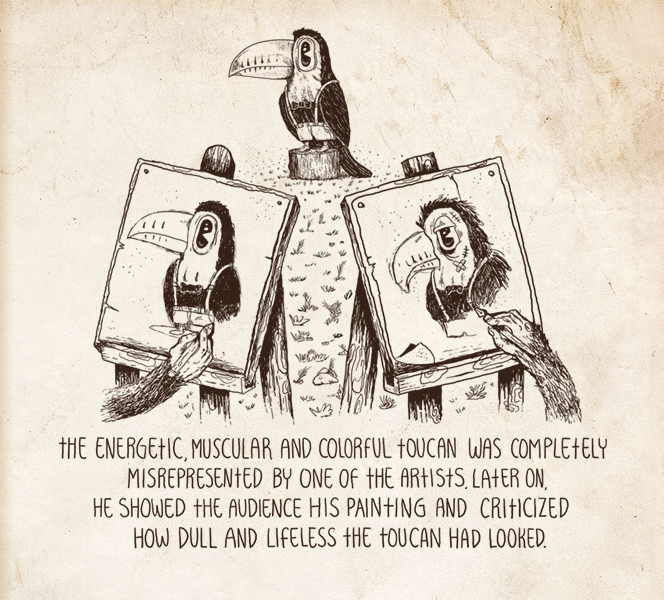
Das Berufen auf eine Autorität ist ein Berufen auf die eigene Bescheidenheit [Engel], d. h. ein Berufen auf das Gefühl, dass andere mehr wissen. Das ist bequem und es ist auch eine ganz natürliche menschliche Tendenz. Allerdings finden wir durch dieses Berufen nicht heraus, ob etwas wahr oder falsch ist. Jedes Berufen auf eine Autorität ist ein genetischer Fehlschluss. Experten haben nicht die Eigenschaft, absolute Wahrheiten zu produzieren. Um Wahrheit von Unwahrheit zu unterscheiden, müssen wir uns auf evidenzbasierte Erkenntnisse und logische Schlussfolgerungen stützen.
Das Berufen auf eine relevante Autorität kann uns jedoch zeigen, was wahrscheinlich wahr ist. So kommen wir zu Überzeugungen. Die überwältigende Mehrheit dieser Überzeugungen – sei es die Existenz von Atomen oder des Sonnensystems – verlangt uns ab, dass wir uns auf verlässliche Autoritäten berufen. Ebenso verhält es sich mit allen geschichtlichen Aussagen, um C. S. Lewis zu paraphrasieren.
Ein Argument ist fehlerhaft, wenn es sich auf eine Autorität beruft, die auf dem entsprechenden Gebiet kein Experte ist. Ähnlich verhält es sich mit dem Berufen auf eine vage Autorität, wobei eine Erkenntnis einem vagen Kollektiv zugeschrieben wird, z. B. „Professoren in Deutschland haben dies und jenes bewiesen.“ Eine weitere Form des Berufens auf eine irrelevante Autorität ist das Berufen auf althergebrachte Weisheiten. Hierbei wird angenommen, dass etwas wahr ist, weil es früher einmal für wahr gehalten wurde, z. B. „Astrologie wurde in technisch fortgeschrittenen Zivilisationen praktiziert, z. B. im frühen China. Sie muss also wahr sein.“ Das Berufen auf althergebrachte Weisheiten kann außerdem dazu genutzt werden, Sachverhalte zu untermauern, die eigentümlich sind oder sich mit der Zeit ändern. Argumente dieser Art müssen zunächst die Evidenz, über die wir heute verfügen, in Betracht ziehen.
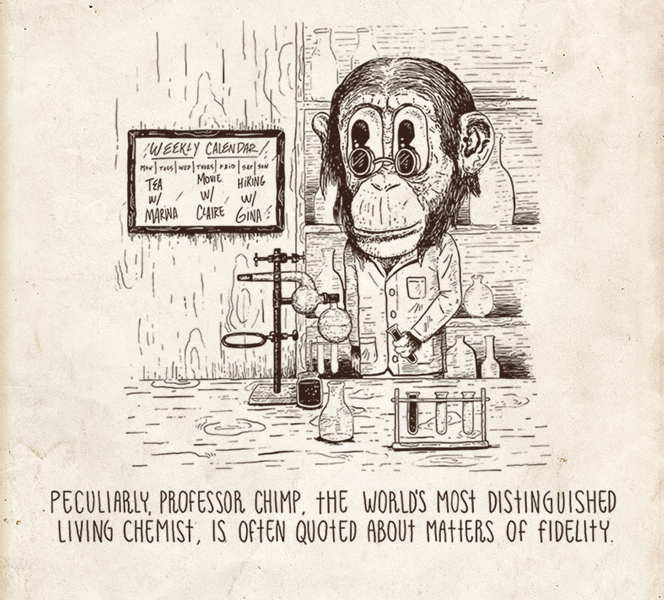
Bei der Äquivokation wird die Mehrdeutigkeit von Sprache dadurch ausgenutzt, dass die Bedeutung eines Wortes im Argumentationsverlauf geändert wird. Diese verschiedenen Bedeutungen werden dann genutzt, um eine Schlussfolgerung zu untermauern. Ein Wort, dessen Bedeutung in einer Argumentation durchweg beibehalten wird, bezeichnet man als univok verwendet. Betrachten wir folgende Situation: Zwei Manager kommen für eine Beförderung in Frage. In einem Meeting mit der Chefin lässt einer sein Wasserglas fallen. Daraufhin proklamiert der andere: „Er kann doch hier keine Verantwortung tragen, wenn er ständig alles fallen lässt!“ Hier findet eine Bedeutungsverschiebung des Wortes tragen statt: von dem Obliegen von Verantwortung zum physischen Festhalten eines Gegenstands.
Dieser Fehlschluss begegnet einem auch oft in Diskussionen über Wissenschaft und Religion, in denen das Fragewort warum äquivok verwendet wird. Es kann, je nach Kontext, nach der Ursache fragen – einer grundlegenden Motivation für wissenschaftliche Forschung – oder nach dem Sinn – und sich somit mit der Moral beschäftigen und mit Wissenslücken, auf welche die Wissenschaft oft keine Antworten hat. So begegnet einem z. B. folgendes Argument: „Die Wissenschaft kann nicht erklären, warum Dinge geschehen. Warum existieren wir? Warum sollte man moralisch handeln? Deshalb brauchen wir eine andere Quelle, die uns erklärt, warum Dinge geschehen.“
2 Diese Illustration basiert auf einem Gespräch zwischen Alice und der Weißen Königin in Lewis Carrolls Alice hinter den Spiegeln [Carroll3].
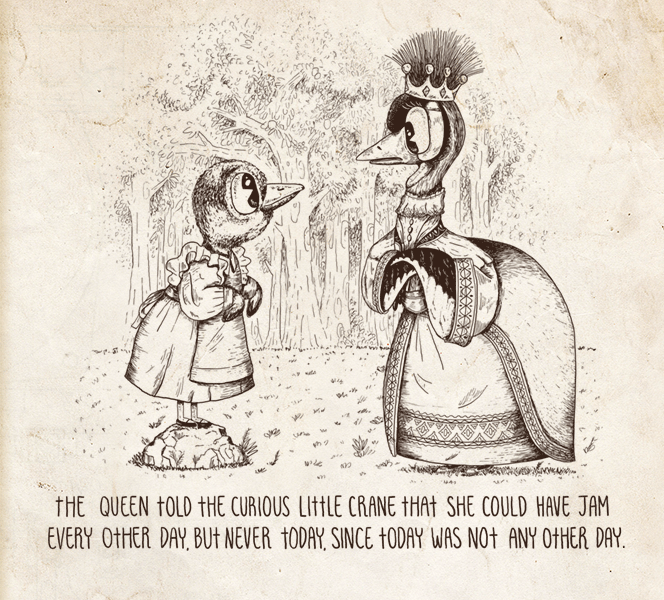
Ein falsches Dilemma ist ein Argument, welches eine aus zwei möglichen Kategorien bestehende Menge vorstellt, mit der Annahme, dass alles im Rahmen der laufenden Diskussion Erwähnte ein Element dieser Menge sein muss. Wird eine der beiden Kategorien abgelehnt, so muss die andere akzeptiert werden. Nehmen wir folgendes Beispiel: „Im Krieg gegen den Fanatismus gibt es keine Zuschauer. Du bist entweder auf unserer Seite oder auf der Seite der Fanatiker.“ In Wirklichkeit gibt es noch eine dritte Option – man könnte neutral sein – und eine vierte Option – man könnte gegen beide sein – und sogar eine fünfte Option – man könnte Aspekte beider Standpunkte verstehen.
In dem Buch The Strangest Man wird erwähnt, dass der Physiker Ernest Rutherford seinem Kollegen Niels Bohr einmal eine Parabel erzählte, in der ein Mann einen Papageien in der Tierhandlung kauft und ihn bald darauf wieder zurückbringt, weil dieser nicht spricht. Nachdem dies ein paar Mal passiert, sagt der Geschäftsführer schließlich: „Oh, das stimmt! Sie wollten einen Papageien, der spricht. Bitte entschuldigen Sie! Ich habe Ihnen einen gegeben, der denkt.“ Rutherford nutzte diese Parabel natürlich, um das Genie des schweigsamen Dirac aufzuzeigen. Es wäre aber auch denkbar, dass jemand sich einer ähnlichen Argumentation bedienen könnte, um anzudeuten, dass eine Person entweder ein stiller Denker oder ein redseliger Idiot ist.
3 Dieser Fehlschluss wird auch als Fehlschluss der ausgenommenen Mitte, Schwarz-Weiß-Fehlschluss, Entweder-oder-Fehlschluss, als falsche Disjunktion oder als falsche Dichotomie bezeichnet.
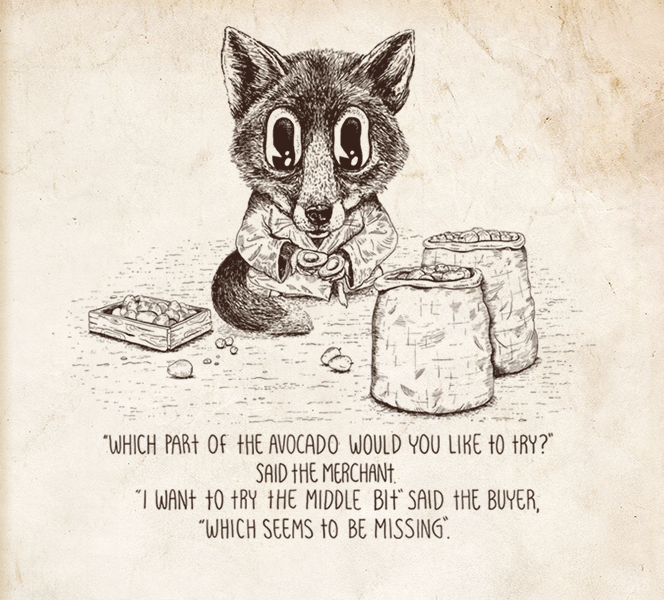
Dieser Fehlschluss spricht einem Ereignis eine bestimmte Ursache zu, obwohl es dafür keine Belege gibt. Zwei Ereignisse können aus verschiedenen Gründen nacheinander oder gleichzeitig eintreten. Es könnte eine Korrelation, Zufall oder ein drittes unbekanntes Ereignis zugrunde liegen. Ohne Belege kann man nicht auf einen kausalen Zusammenhang schließen. „Das Erdbeben neulich fand statt, weil das Volk dem König nicht gehorchte“ ist kein gutes Argument.
Diesem Fehlschluss begegnet man in zwei Ausprägungen: „nach diesem, deshalb aufgrund dessen“ und „mit diesem, deshalb aufgrund dessen“. Im ersten Fall geht ein Ereignis einem anderen voraus und wird deshalb als Ursache gedeutet. Im letzteren Fall tritt das Ereignis gleichzeitig mit einem anderen ein. In verschiedenen Disziplinen wird dies auch als Verwechslung von Korrelation und Kausalität bezeichnet.4
Hier ein Beispiel. Der Komiker Stewart Lee sagte einmal sinngemäß: „Nur weil ich 1976 einmal einen Roboter gezeichnet habe und danach Star Wars in die Kinos kam, kann ich nicht behaupten, dass sie die Idee von mir abgeguckt haben.“ Hier ein weiteres Beispiel, auf das ich kürzlich in einem Onlineforum stieß: „Der Hacker hat die Website der Eisenbahngesellschaft zum Absturz gebracht und als ich mir danach die Abfahrtszeiten der Züge angeschaut habe, waren tatsächlich alle verspätet! Wer hätte das gedacht!“ Der Nutzer hatte jedoch nicht bedacht, dass diese Züge sowieso nur selten pünktlich sind. Ohne jegliche Art von wissenschaftlichem Kontrollversuch ist seine Schlussfolgerung also unbegründet.
4 Wie sich herausstellt, besteht eine hohe Korrelation zwischen dem Verzehr von Schokolade und dem Erhalten eines Nobelpreises, was wohl bei so manch einem Schokoladenesser Hoffnungen weckt.
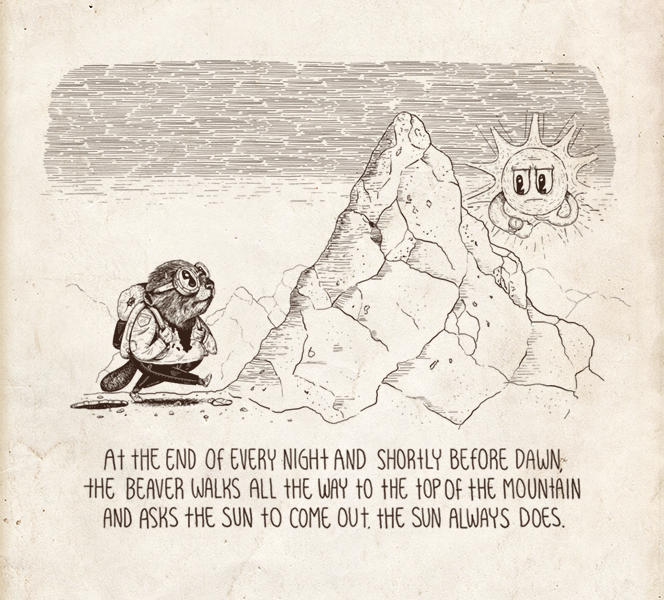
Bei diesem Fehlschluss wird mit den Ängsten des Publikums gespielt, indem eine angsteinflö-ßende Zukunft heraufbeschworen wird, die bei Akzeptanz einer Aussage eintreten würde. Es werden jedoch keine Beweise dafür geliefert, dass diese Konklusion tatsächlich aus einer Reihe von Prämissen folgt (was legitimen Anlass zur Angst liefern könnte). Stattdessen beruhen Argumente dieser Art auf rhetorischem Können, Drohungen oder blanken Lügen. Nehmen wir folgendes Beispiel: „Ich bitte alle Mitarbeiter, in den anstehenden Wahlen für meinen Wunschkandidaten zu stimmen. Falls der Gegenkandidat gewinnt, wird er eine Steuererhöhung beschließen und ihr werdet alle eure Arbeit verlieren.“
Hier ein weiteres sinngemäßes Beispiel aus Der Prozeß: „Es ist besser, Sie geben die Sachen uns als ins Depot“, sagten sie, „denn im Depot kommen öfters Unterschleife vor…“ [Kafka]. Obwohl das Argument hier wahrscheinlich eine – wenn auch unterschwellige – Drohung darstellt, wird zumindest versucht zu argumentieren. Nackte Drohungen oder Befehle, bei denen gar kein Versuch unternommen wird, Beweise zu liefern, sollten nicht mit Fehlschlüssen verwechselt werden, auch wenn sie ebenfalls die Angst einer Person ausnutzen [Engel].
Bei einem Angstargument werden oft eine Reihe von angsteinflößenden Ereignissen beschrieben, die angeblich eintreten würden, falls eine Aussage akzeptiert wird, wobei jedoch keine klare kausale Beziehung zwischen Aussage und Ereignissen besteht; in diesem Fall ähnelt das Argument dem Dominoeffekt. In einigen Fällen wird dem Gegenüber außerdem nur eine Alternative zur angegriffenen Aussage präsentiert, und zwar die des Angreifers; in diesem Fall ähnelt das Angstargument einem falschen Dilemma.
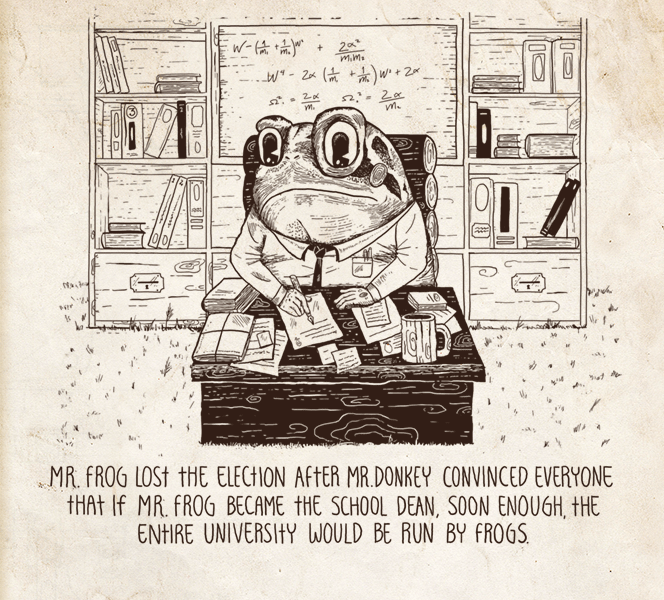
Dieser Fehlschluss liegt vor, wenn auf Basis einer Stichprobe, die entweder zu klein oder zu speziell ist, um für eine Population repräsentativ zu sein, verallgemeinert wird. So kann man z. B., nachdem man zehn Personen auf der Straße nach ihrer Meinung zu den Haushaltsmaßnahmen des Präsidenten befragt hat, hieraus keinesfalls auf die Stimmung des gesamten Landes schließen.
Auch wenn sie gelegen kommen, können übereilte Verallgemeinerungen kostspielige und katastrophale Folgen haben. Man könnte z. B. argumentieren, dass die ingenieurwissen-schaftlichen Annahmen, die zur Explosion der Ariane 5 während ihres Jungfernflugs führten, eine Folge übereilter Verallgemeinerung waren. Die für das Kontrollsystem der Ariane 4 verwendeten Testfälle reichten nicht aus, um das notwendige Spektrum an Anwendungsfällen für das Ariane 5-Kontrollsystem abzudecken. Bei solchen Entscheidungen kommt es oft auf die Argumentationsfähigkeit der Ingenieure und Manager an – daher die Relevanz dieses und ähnlicher Beispiele für unsere Diskussion logischer Fehlschlüsse.
Hier ein weiteres Beispiel aus Alice's Abenteuer im Wunderland. In dieser Szene treibt Alice in einem Gewässer herum und schlussfolgert, dass deshalb ein Bahnhof – und somit Hilfe – in der Nähe sein muss: „Alice war einmal in ihrem Leben an der See gewesen und war zu dem all-gemeinen Schluss gelangt, dass wo man auch ans Seeufer kommt, man eine Anzahl Bademaschinen im Wasser findet, Kinder, die den Sand mit hölzernen Spaten aufgraben, dann eine Reihe Wohnhäuser und dahinter eine Eisenbahnstation.“ [Carroll2]
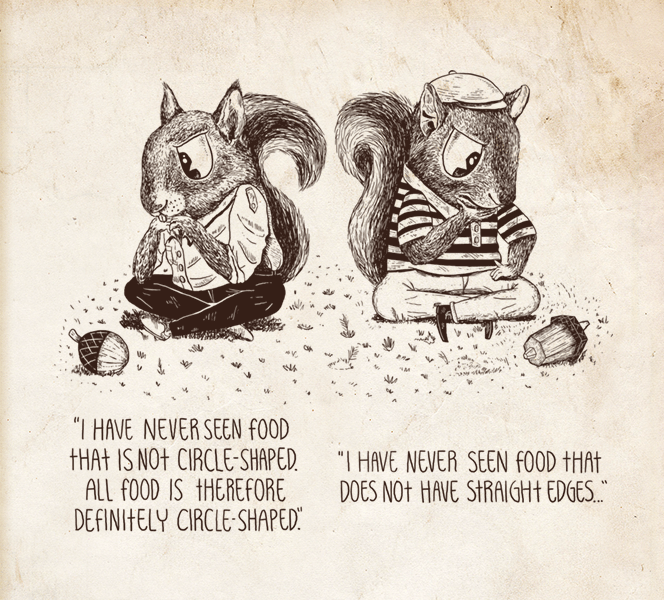
Bei einem Argument dieser Art wird eine Aussage allein deshalb als wahr akzeptiert, weil es keinen Beweis dafür gibt, dass sie es nicht ist. Die Nichtexistenz eines Beweises wird hier als Beweis für Nichtexistenz gedeutet. Ein Beispiel hierzu, das von Carl Sagan stammt: „Es gibt keine überzeugenden Beweise dafür, dass die Erde nicht von UFOs besucht wird; also muss es UFOs geben.“ Ähnlich verhielt es sich, als man noch nicht wusste, wie der Bau der Pyramiden abgelaufen war. Einige beharrten damals darauf, dass – solange nicht das Gegenteil bewiesen wurde – eine übermenschliche Macht am Werk gewesen sein musste. Die Beweislast obliegt immer demjenigen, der eine These aufstellt.
Darüber hinaus muss man sich – wie es bereits viele vor mir getan haben – fragen, welche Option – basierend auf den durch frühere Beobachtungen gesammelten Belegen – wahrscheinlicher ist. Ist es wahrscheinlicher, dass ein fliegendes Objekt ein von Menschen geschaffenes Artefakt oder ein Naturphänomen darstellt oder dass es außerirdische Besucher von einem anderen Planeten sind? Da wir Ersteres schon häufig und Letzteres noch nie beobachtet haben, ist es vernünftiger zu folgern, dass UFOs wahrscheinlich keine außerirdischen Besucher sind.
Eine spezielle Art des Berufens auf Nichtwissen ist das Argument der persönlichen Ungläubigkeit. Hierbei wird aus der Unfähigkeit einer Person, sich etwas vorzustellen, die Überzeugung abgeleitet, dass das vorgebrachte Argument falsch ist. Ein Beispiel: „Es ist unvorstellbar, dass wir tatsächlich einen Mann auf den Mond geschickt haben. Also ist es nie passiert.“ Antworten dieser Art werden ab und an geistreich mit „Deswegen bist du auch kein Physiker“ pariert.
5 Als Inspiration für die Illustration diente Neil deGrasse Tysons Antwort auf eine Zuschauerfrage zum Thema UFOs: youtu.be/NSJElZwEI8o.
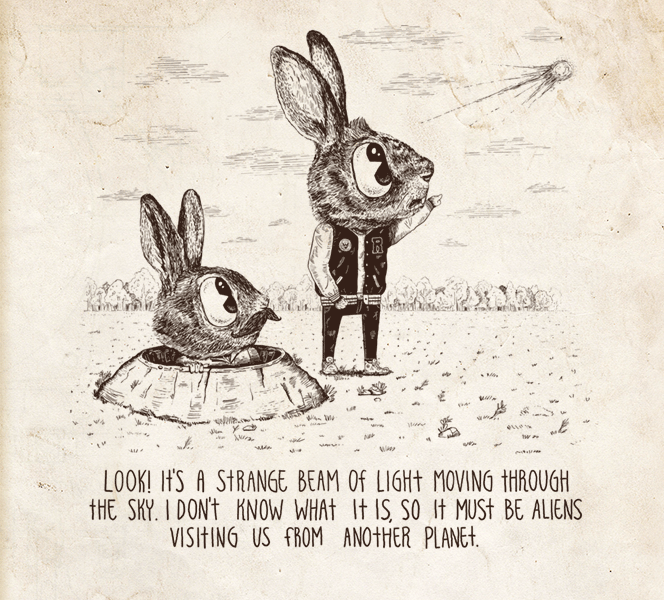
Manchmal werden allgemeine Behauptungen aufgestellt, die sich auf eine bestimmte Kategorie von Dingen beziehen. Werden Gegenbeweise zu einer solchen Behauptung vorgebracht, werden sie bei dieser Art des Argumentierens weder akzeptiert noch abgelehnt – stattdessen wird das Gegenargument dadurch pariert, dass die Kriterien für die Zugehörigkeit zu der entsprechenden Kategorie willkürlich umdefiniert werden.6
Man kann z. B. die These aufstellen, dass Programmierer sozial inkompetent seien. Wenn nun jemand auftaucht und diese These widerlegt, indem er sagt, „Aber John ist Programmierer und er ist überhaupt nicht sozial inkompetent“, könnte er darauf als Antwort erhalten, „Ja, aber John ist auch kein echter Programmierer.“ In diesem Fall ist nicht klar, welche Eigenschaften einen Programmierer ausmachen; außerdem ist die Kategorie nicht so eindeutig definiert wie z. B. Menschen mit blauen Augen. Diese Ambiguität erlaubt es dem störrischen Hirn, Dinge willkürlich umzudefinieren.
Dieser Fehlschluss wurde von Antony Flew in seinem Buch Thinking about Thinking geprägt. Dort führt er folgendes Beispiel an: Hamish liest Zeitung und entdeckt dabei einen Artikel über einen Engländer, der ein abscheuliches Verbrechen begangen hat. Er sagt sich: „Kein Schotte würde so etwas je tun.“ Am nächsten Tag entdeckt er einen Beitrag über einen Schotten, der ein noch schlimmeres Verbrechen begangen hat. Anstatt seine These zu revidieren, sagt er sich nun: „Kein echter Schotte würde so etwas je tun.“
6 Wenn jemand eine Kategorie mutwillig umdefiniert, und das im vollen Bewusstsein, dass er oder sie diese damit verfälscht darstellt, ähnelt diese Form der Argumentation dem Strohmann-Argument.

Die Herkunft eines Arguments oder die Herkunft der Person, die das Argument vorbringt, haben nicht den geringsten Einfluss auf die Gültigkeit dieses Arguments. Ein genetischer Fehlschluss liegt vor, wenn ein Argument allein aufgrund seiner Entstehungsgeschichte entwertet oder verteidigt wird. T. Edward Damer schreibt hierzu, dass es im Falle einer emotionalen Bindung an die Herkunft einer Idee nicht immer einfach ist, diese abzulegen, wenn es um die Bewertung der Idee selbst geht.
Nehmen wir folgendes Argument: „Natürlich unterstützt er die streikenden Gewerkschafter. Er kommt ja aus demselben Dorf.“ Hier wird ein Argument nicht sachlich bewertet. Stattdessen wird es verworfen, da die Person, die es hervorbringt, zufällig aus demselben Dorf stammt wie die Demonstranten. Auf Basis dieser Information wird dann geschlussfolgert, dass das Argument wertlos sei. Hier ein weiteres Beispiel: „Wir leben im 21. Jahrhundert. Wir können nicht an diesen steinzeitlichen Ideen festhalten.“ Warum nicht, könnte man da fragen. Sollten wir alle Ideen, die aus der Steinzeit stammen, allein aufgrund ihres Alters ablehnen?
Im Gegenzug kann ein genetischer Fehlschluss auch im positiven Sinne auftreten, z. B. indem gesagt wird: „Jacks Ansichten über Kunst sind über alles erhaben; er entstammt einem alten Künstlergeschlecht.“ In diesem Fall fehlt der Beleg für die Schlussfolgerung genauso wie in den beiden vorausgehenden Beispielen.
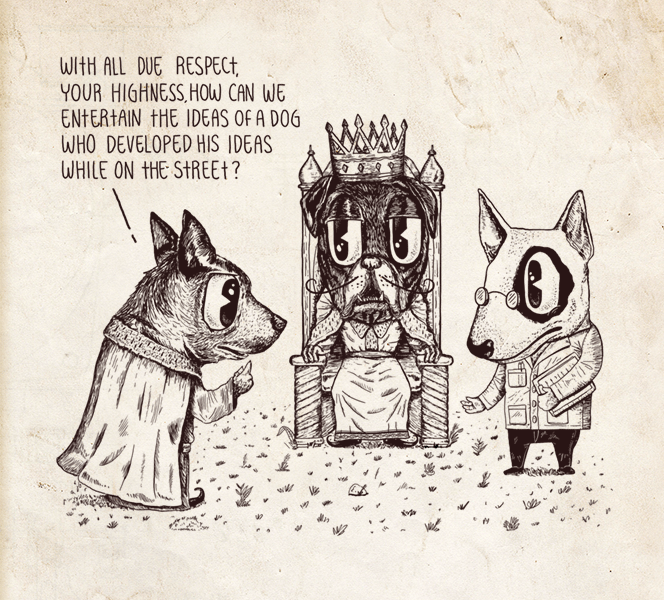
Bei der Zuweisung von Schuld durch Zugehörigkeit versucht man, ein Argument zu untergraben, weil es eine Idee unterstützt, die auch von einer sozial geächteten Person oder Gruppe vertreten wird. Betrachten wir folgendes Beispiel: „Mein Herausforderer setzt sich für ein Gesundheits-system ein, das man ähnlich auch in sozialistischen Ländern findet. Das ist selbstverständlich vollkommen inakzeptabel.“ Ob das vorgeschlagene Gesundheitssystem denjenigen in sozialistischen Ländern ähnelt oder nicht, sagt allerdings nicht das Geringste darüber aus, ob es ein gutes System ist. Die Folgerung entbehrt jeder logischen Grundlage.
Eine weitere Diskussion, die sich in einigen Gesellschaften ad nauseum wiederholt, ist diese: „Wir dürfen Frauen das Autofahren nicht erlauben, weil Menschen in gottlosen Ländern es erlauben, dass ihre Frauen Auto fahren.“ In diesem und dem vorausgehenden Beispiel wird versucht zu argumentieren, dass eine bestimmte Gruppe Menschen absolut und kategorisch schlecht ist. Wenn man auch nur eine Eigenschaft dieser Gruppe teilt, wird man somit automatisch zu einem Teil von ihr, was einem wiederum alle mit dieser Gruppe assoziierten schlechten Eigenschaften verleiht.
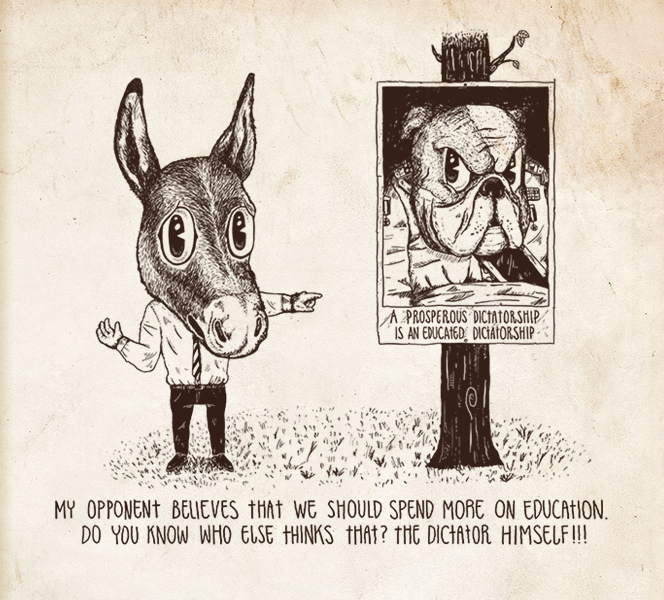
Eine von mehreren sog. gültigen Schlussfiguren ist der modus ponens oder die setzende Schlussfigur, die folgende Form annimmt: Wenn A, dann C. A, also C. Formal wird sie wie folgt ausgedrückt:
A ⇒ C, A ⊢ C.
Wir haben hier drei Aussagen: zwei Prämissen und eine Konklusion. A wird als Antezedenz bezeichnet und C als Sukzedenz. Ein Beispiel: „Falls Wasser bei Normalnull kocht, beträgt seine Temperatur mind. 100°C. Das Wasser in diesem Glas kocht bei Normalnull, also beträgt seine Temperatur mind. 100°C.“ Ein solches Argument ist sowohl gültig als auch schlüssig.
Ein ungültiger Umkehrschluss ist ein formeller Fehlschluss, der die folgende Form annimmt: Wenn A, dann C. C, also A.
Der hier begangene Fehler liegt in der Annahme, dass eine wahre Sukzedenz bedeutet, dass die Antezedenz ebenfalls wahr ist. Dies muss jedoch nicht der Fall sein. Ein Beispiel: „Menschen, die studieren, sind erfolgreicher im Leben. John ist erfolgreich, also muss John studiert haben.“ Natürlich könnte Johns Erfolg ein Ergebnis seiner Bildung sein. Er könnte aber ebenso gut auf seine Erziehung zurückzuführen sein, oder auf sein Bestreben, sich hochzuarbeiten. Allgemeiner ausgedrückt kann man aus der Tatsache, dass Bildung Erfolg impliziert, nicht folgern, dass Erfolg zwangsläufig auf Bildung zurückzuführen ist.

Dieser Fehlschluss ist auch unter seinem lateinischen Namen, tu quoque, dt. auch du, bekannt. Anstatt auf das hervorgebrachte Argument einzugehen, wird hierbei ein Vorwurf mit einem Vorwurf pariert – und zwar mit dem Ziel, die Aufmerksamkeit vom ursprünglichen Argument wegzulenken. So sagt John z. B.: „Dieser Mann hat Unrecht, weil er nicht integer ist. Fragen Sie ihn nur einmal, warum ihn sein letzter Arbeitgeber gefeuert hat.“ Darauf antwortet Jack: „Wie wäre es denn, wenn wir uns einmal über den saftigen Bonus unterhalten, den Sie letztes Jahr erhalten haben, obwohl Ihre Firma gerade Stellen abbaut.“ Ein Berufen auf Heuchelei kann auch vorliegen, wenn eine Person ihr Gegenüber angreift, weil dessen Argumente und bisheriges Verhalten miteinander in Konflikt stehen [Engel].
In einer Folge der britischen Satiresendung Have I Got News For You erhob eine Diskussions-teilnehmerin Einwände gegen eine Demonstration in London, bei der gegen die Geldgier der Wirtschaft protestiert wurde. Sie verwies auf die augenscheinliche Heuchelei der Demonstrierenden. Diese schienen den Kapitalismus zwar abzulehnen, nutzten aber weiterhin Smartphones und kauften Kaffee. Der Ausschnitt ist hier zu sehen.
Hier ist ein weiteres Beispiel aus Jason Reitmans Film Thank You for Smoking (Fox Searchlight Pictures, 2005), in dem der aalglatte Tabaklobbyist Nick Naylor einen Schlagabtausch voller Tu quoque mit den folgenden Worten beendet: „Ich find's einfach klasse, dass dieser Gentleman aus Vermont mich einen Heuchler nennt und derselbe Mann morgens in einer Pressekonferenz dazu aufruft, amerikanische Tabakfelder niederzubrennen, dann mit einem Privatjet zu einem Benefizkonzert fliegt, dort mit einem Traktor auf die Bühne fährt und sich über den Niedergang der amerikanischen Farmer beklagt.“
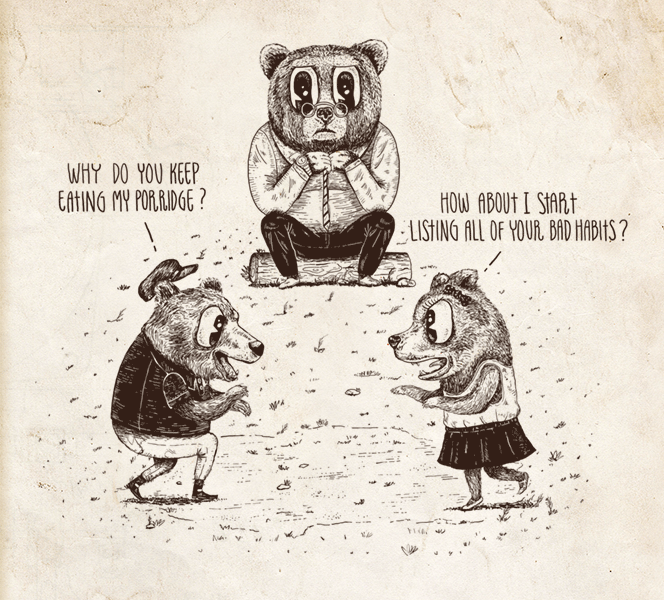
Ein Berufen auf den Dominoeffekt7 stellt einen Versuch dar, eine Aussage zu untergraben, indem argumentiert wird, dass das Akzeptieren dieser Aussage unweigerlich eine Abfolge von Ereignissen auslösen wird, von der eines oder mehrere unerwünscht sind. Es mag möglich sein, dass sich diese Abfolge von Ereignissen tatsächlich ereignet, wobei jeder einzelne Schritt von einem Ereignis zum nächsten mit einer gewissen Wahrscheinlichkeit eintritt. Der Dominoeffekt nimmt jedoch an, dass jeder dieser Schritte unausweichlich ist, wobei keine Belege für diese Annahme geliefert werden. Dieser Fehlschluss nutzt so die Ängste eines Publikums aus und ähnelt verschiedenen anderen Fehlschlüssen, wie dem Angstargument, dem falschen Dilemma und dem Berufen auf die Folgen.
Nehmen wir folgendes Beispiel: „Menschen sollten keinen unkontrollierten Zugang zum Internet haben. Sonst tummeln sie sich, ehe man es sich versieht, alle auf pornografischen Webseiten. Das moralische Gefüge unsere Gesellschaft wird auseinanderbrechen und wir werden alle zu Tieren.“ Es ist glasklar, dass abgesehen von unbegründeten Annahmen keine Belege dafür angeführt werden, dass der Zugang zum Internet das Auseinanderbrechen des moralischen Gefüges unserer Gesellschaft nach sich ziehen wird. Außerdem werden Vorannahmen über das Verhalten von Internetnutzern gemacht.
7 Der hier beschriebene Dominoeffekt ist ein kausaler Dominoeffekt.
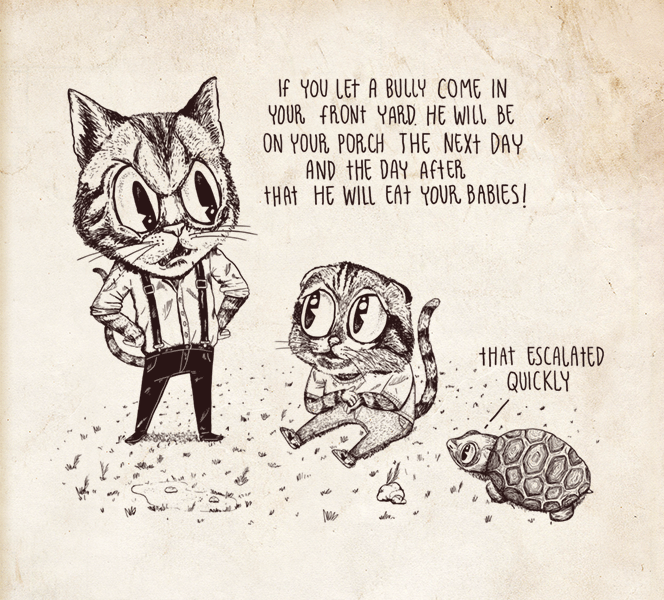
Auch als argumentum ad populum bekannt. Ein Argument dieser Art nutzt die Tatsache, dass viele Menschen – evtl. sogar die Mehrheit – eine Sache glauben, als Beweis für dessen Wahrheitsgehalt. Einige der Argumente, die in der Vergangenheit die umfassende Akzeptanz vieler bahnbrechender Ideen erschwert haben, passen in diese Kategorie. So wurde Galileo von seinen Zeitgenossen verspottet, weil er ein Verfechter des kopernikanischen Weltbildes war. In jüngerer Zeit musste der Mediziner Barry Marshall auf die radikale Maßnahme zurückgreifen, sich selbst zu infizieren, um seine Kollegen davon zu überzeugen, dass Magengeschwüre durch das Bakterium H. pylori verursacht werden können: eine Theorie, die bis dato weithin abgelehnt wurde.
Menschen dazu zu verleiten, Beliebtes als Wahres zu akzeptieren, ist eine in der Werbung und der Politik häufig verwendete Methode. Nehmen wir folgendes Beispiel: „Alle Coolen benutzen dieses Haargel. Gehöre auch dazu!“ Zu den Coolen zu gehören ist zwar ein verlockendes Angebot; es liefert jedoch keinen zwingenden Grund, der Kaufaufforderung zu folgen. Politiker greifen oft auf ähnliche rhetorische Mittel zurück, um den Wahlkampf anzuheizen und Wähler zu beeinflussen.
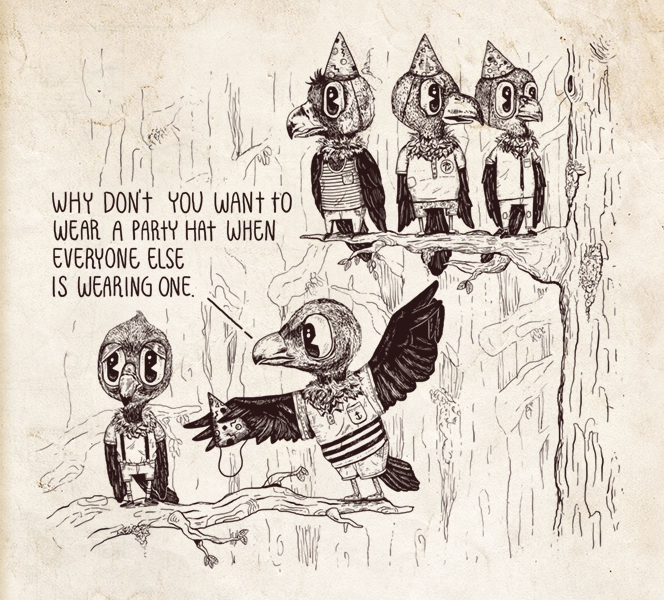
Ein argumentum ad hominem greift nicht die Aussagen einer Person an, sondern ihren Charakter – und zwar mit dem Ziel, die Diskussion in andere Bahnen zu lenken und das Argument der Person zu diskreditieren. Nehmen wir folgendes Beispiel: „Sie sind kein Historiker. Warum bleiben Sie nicht bei Ihrer eigenen Disziplin?“ Ob die betreffende Person Historiker ist oder nicht, hat keinerlei Auswirkung auf die Güte ihres Arguments und trägt nicht dazu bei, die argumentative Position des Angreifers zu stärken.
Diese Art des persönlichen Angriffs wird als missbräuchliches ad hominem (abusive ad hominem) bezeichnet. Eine zweite Spielart, das performative ad hominem (circumstantial ad hominem), bezeichnet jedes Argument, das eine Person aus zynischen Gründen angreift, indem es deren Absichten infrage stellt, z. B.: „Sie sind überhaupt nicht daran interessiert, Kriminalitäts-raten im städtischen Raum zu senken. Sie wollen nur wiedergewählt werden.“ Es gibt allerdings auch Situationen, in denen es legitim ist, den Charakter und die Integrität einer Person infrage zu stellen, z. B. während einer Zeugenvernehmung.
8 Die Inspiration für die Illustration lieferte eine Diskussion auf Usenet vor einigen Jahren, in die ein übereifriger und verstockter Programmierer verwickelt war.
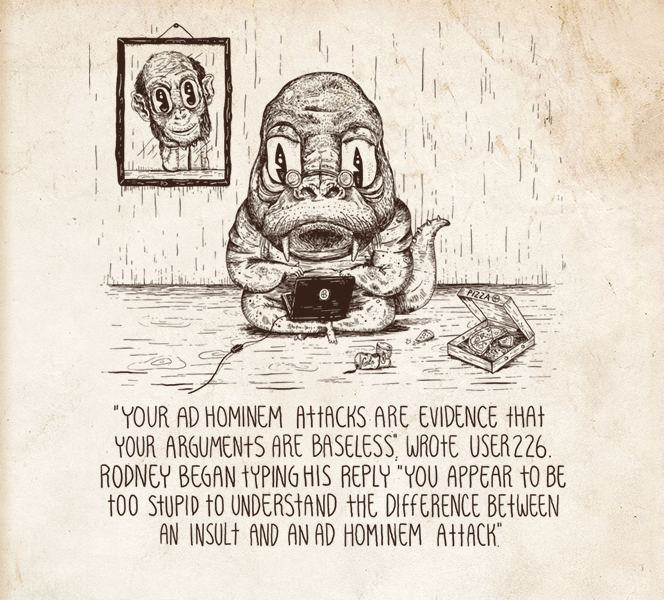
Ein Zirkelschluss ist eine der vier Formen des Petitio Principii-Fehlschlusses (begging the question) [Damer], bei dem die Konklusion in einer oder mehreren Prämissen implizit oder explizit vorweggenommen wird. Bei einem Zirkelschluss wird die Konklusion entweder offensichtlich als Prämisse verwendet oder – was häufiger der Fall ist – so umformuliert, dass sie eine andere Aussage zu sein scheint, obwohl dies in Wirklichkeit nicht der Fall ist, z. B.: „Du hast vollkommen Unrecht, weil du nur Unsinn redest.“ In diesem Fall bedeuten beide Aussagen dasselbe, da Unrecht haben und Unsinn reden in diesem Zusammenhang denselben Sachverhalt beschreiben. Das Argument sagt lediglich aus, dass aus X X folgt, was vollkommen nichtssagend ist.
Manchmal stützt sich ein Zirkelschluss auf unausgesprochene Prämissen, was seine Enttarnung verkompliziert. Nehmen wir folgendes Beispiel aus der australischen Fernsehserie Please Like Me, in der einer der Charaktere einen anderen – einen Ungläubigen – in die Hölle verdammt, worauf der Angegriffene antwortet: „[Das] ist total sinnlos. Das ist so, wie wenn ein Hippie dir droht, dir in die Aura zu schlagen.“ In diesem Beispiel lautet die unausgesprochene Prämisse, dass es einen Gott gibt, der einige Menschen in die Hölle verbannt. Somit ist der einzige Beleg, der die Prämisse „Es gibt einen Gott, der Ungläubige in die Hölle verbannt“ stützt, die Behauptung, dass der Ungläubige in die Hölle kommen wird. Diese Behauptung ist wiederum die Konklusion aus der Aussage „Es gibt einen Gott, der Ungläubige in die Hölle verbannt“ und der Feststellung, dass die betreffende Person ein Ungläubiger ist.
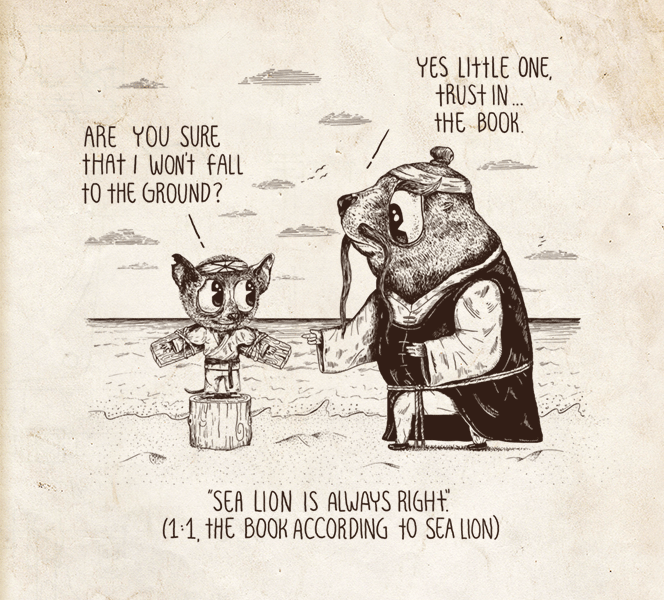
Der Fehlschluss der Komposition folgert, dass ein Ganzes über eine bestimmte Eigenschaft verfügen muss, weil seine Bestandteile über diese Eigenschaft verfügen. Auch wenn jedes Schaf in der Herde eine Mutter hat, hat die Herde deswegen jedoch nicht unbedingt eine Mutter, um Peter Millican zu paraphrasieren. Nehmen wir ein weiteres Beispiel: „Jedes Modul dieses Software-systems wurde einer Reihe von Komponententests unterzogen und hat alle bestanden. Wenn die Module nun integriert werden, wird das Softwaresystem deshalb keine der Invarianten verletzen, die durch die Komponententests überprüft wurden.“ Tatsächlich wird jedoch durch die Integration der einzelnen Bestandteile aufgrund ihrer Abhängigkeiten untereinander eine neue Komplexitätsebene eingeführt. So wird neues Fehlerpotenzial geschaffen.
Andersherum folgert der Fehlschluss der Division, dass ein Bestandteil eines Ganzen über eine bestimmte Eigenschaft verfügen muss, weil das Ganze über diese Eigenschaft verfügt. Ein Beispiel: „Unsere Mannschaft ist unschlagbar. Jeder einzelne unserer Spieler könnte es mit jedem einzelnen Spieler jeder anderen Mannschaft aufnehmen und ihn in den Schatten stellen.“ Auch wenn es stimmen mag, dass die Mannschaft als Ganzes unschlagbar ist, kann dies nicht als Beweis dafür herangezogen werden, dass jeder einzelne ihrer Spieler unschlagbar ist. Der Erfolg einer Mannschaft ergibt sich nicht immer aus der Summe der individuellen Fähigkeiten ihrer Spieler.
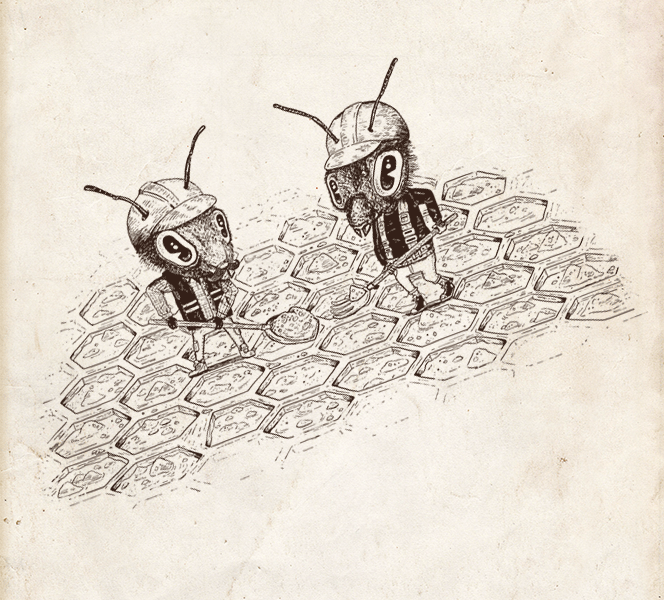

Vor vielen Jahren hörte ich einmal, wie ein Professor deduktive Argumente mit einer wundervollen Metapher umschrieb. Er bezeichnete sie als wasserdichte Rohre, in die Wahrheit hinein- und am anderen Ende wieder herausfließt. Die Metapher diente als Inspiration für das Titelbild. Nun sind Sie am Ende dieses Buches angelangt. Ich hoffe, dass Sie nicht nur den Mehrwert besser verstehen, den wasserdichte Argumente für die Überprüfung und das Mehren von Wissen mit sich bringen, sondern auch die Komplexität induktiver Argumente, die von Wahrscheinlichkeiten abhängen. Gerade bei solchen Argumenten ist kritisches Denken als Werkzeug unabdingbar. Ich hoffe, dass Sie durch die Lektüre außerdem ein Gefühl dafür bekommen haben, welche Gefahren von fadenscheinigen Argumenten ausgehen und wie weitverbreitet sie in unserem Alltag sind.
Unten geht’s weiter · Auf Twitter oder Facebook teilen

Aussage: Eine Behauptung, die entweder wahr oder falsch ist, aber nicht beides. Beispiel: „Boston ist die größte Stadt in Massachusetts.“
Prämisse: Eine Aussage, welche die Schlussfolgerung eines Arguments unterstützt. Ein Argument kann eine oder mehrere Prämissen haben.
Argument: Eine Menge von Aussagen, deren Ziel es ist, durch Beweisführung zu überzeugen. Ein Argument besteht aus einer Untermenge von Aussagen, sog. Prämissen, die eine weitere Aussage, die Konklusion, unterstützen.
Deduktives Argument: Ein Argument, bei dem die Konklusion wahr ist, falls die Prämissen wahr sind. Die Konklusion geht logisch zwingend aus den Prämissen hervor. Beispiel: „Alle Männer sind sterblich. Sokrates ist ein Mann. Also ist Sokrates sterblich.“ Ein deduktives Argument soll gültig sein, ist es aber natürlich nicht immer.
Induktives Argument: Ein Argument, bei dem die Konklusion wahrscheinlich wahr ist, falls die Prämissen wahr sind.9 Die Konklusion folgt daher nicht logisch zwingend aus den Prämissen, sondern beruht auf Wahrscheinlichkeiten. Beispiel: „Jedes Mal, wenn wir die Lichtgeschwindig-keit in einem Vakuum messen, liegt sie bei 3× 108 m/s. Also ist die Lichtgeschwindigkeit eine universelle Konstante.“ Induktive Argumente schließen gewöhnlich von Einzelfällen auf die Allgemeinheit.
9 In den Naturwissenschaften wird gewöhnlich induktiv vorgegangen, indem von Daten auf Gesetze und Theorien geschlossen wird. Deswegen ist die Induktion ein wissenschaftliches Grundprinzip. Unter Induktion versteht man hier das Überprüfen einer Aussage anhand einer Stichprobe, da ein allgemeines Überprüfen entweder nicht praktikabel oder unmöglich wäre.
Logischer Fehlschluss: Ein Argumentationsfehler, der zu einem ungültigen Argument führt. Diese Fehler beziehen sich dabei ausschließlich auf Schlussfolgerungen, durch die von einer Aussage zur nächsten übergeleitet wird, und nicht auf Fakten. Anders ausgedrückt ist eine Aussage nicht zwingend falsch, auch wenn sie das Resultat eines ungültigen Arguments ist. Logische Fehlschlüsse verletzen eines oder mehrere Prinzipien der guten Beweisführung, wie eine klare Struktur, Konsistenz, Klarheit, Ordnung, Relevanz und Vollständigkeit.
Formeller Fehlschluss: Ein logischer Fehlschluss, dessen Form nicht mit der Grammatik und den Schlussregeln eines logischen Kalküls konformgeht. Zur Überprüfung der Gültigkeit eines Arguments reicht es aus, seine abstrakte Struktur zu untersuchen. Eine Betrachtung seines Inhalts ist nicht notwendig.
Informeller Fehlschluss: Ein logischer Fehlschluss, der auf dem Inhalt und Kontext eines Arguments beruht anstatt auf dessen Form. Der Fehler in der Schlussfolgerung sollte ein Fehler sein, der häufig begangen wird, damit das Argument als informeller Fehlschluss gewertet wird.
Gültigkeit: Ein deduktives Argument ist gültig, wenn seine Konklusion logisch aus seinen Prämissen folgt. Andernfalls wird es als ungültig bezeichnet. Die Begriffe gültig und ungültig beziehen sich dabei lediglich auf Argumente und nicht auf Aussagen.
Schlüssigkeit: Ein deduktives Argument ist schlüssig, wenn es gültig ist und auf wahren Prämissen beruht. Falls eine dieser Bedingungen nicht gegeben ist, ist das Argument nicht schlüssig. Der Wahrheitsgehalt wird festgestellt, indem geprüft wird, ob die Prämissen und Konklusionen des Arguments faktisch korrekt sind.
Stärke: Ein induktives Argument ist stark, wenn seine Konklusion mit hoher Wahrschein-lichkeit wahr ist, falls seine Prämissen wahr sind. Wenn die Konklusion nur mit geringer Wahrscheinlichkeit wahr ist, wird es als schwach bezeichnet. Induktive Argumente sind nicht wahrheitskonservierend; es ist nie der Fall, dass aus wahren Prämissen eine wahre Konklusion folgen muss.
Stichhaltigkeit: Ein induktives Argument ist stichhaltig, wenn es stark ist und auf wahren Prämissen beruht, d. h. wenn es faktisch korrekt ist. Andernfalls ist es nicht stichhaltig.
Widerlegbarkeit: Eine Eigenschaft einer Aussage oder eines Arguments, die es erlaubt, sie bzw. es zu widerlegen, etwa durch eine Beobachtung oder ein Experiment. Die Aussage „Alle Blätter sind grün“ kann z. B. durch das Vorlegen eines nichtgrünen Blattes widerlegt werden. Widerlegbarkeit ist ein Zeichen für die Stärke eines Arguments, nicht für dessen Schwäche.

Dieses Quellenverzeichnis wurde aus der englischsprachigen Originalausgabe des Buches übernommen. Deutsche Übersetzungen von Quellen, aus denen direkt zitiert wurde, wurden ergänzt. Alle weiteren Übersetzungen wurden von den Übersetzern selbst angefertigt.
[Aristotle] Aristotle, On Sophistical Refutations, translated by W. A. Pickard, http://classics.mit.edu/Aristotle/sophist_refut.html
[Avicenna] Avicenna, Treatise on Logic, translated by Farhang Zabeeh, 1971.
[Carroll] Lewis Carroll, Alice's Adventures in Wonderland, 2008,
http://www.gutenberg.org/files/11/11-h/11-h.htm
[Carroll2] Lewis Carroll, Alice's Abenteuer im Wunderland, Hartknoch, 1869.
[Carroll3] Lewis Carroll, Alice hinter den Spiegeln, Insel, 2011.
[Curtis] Gary N. Curtis, Fallacy Files, http://fallacyfiles.org
[Damer] T. Edward Damer, Attacking Faulty Reasoning: A Practical Guide to Fallacy-Free Arguments (6th ed), 2005.
[Engel] S. Morris Engel, With Good Reason: An Introduction to Informal Fallacies, 1999.
Unten geht’s weiter · Auf Twitter oder Facebook teilen
[Farmelo] Graham Farmelo, The Strangest Man: The Hidden Life of Paul Dirac, Mystic of the Atom, 2011.
[Fieser] James Fieser, Internet Encyclopedia of Philosophy, http://www.iep.utm.edu
[Firestein] Stuart Firestein, Ignorance: How it Drives Science, 2012.
[Fischer] David Hackett Fischer, Historians' Fallacies: Toward a Logic of Historical Thought, 1970.
[Gula] Robert J. Gula, Nonsense: A Handbook of Logical Fallacies, 2002.
[Hamblin] C. L. Hamblin, Fallacies, 1970.
[King] Stephen King, On Writing, 2000.
[King2] Stephen King, Das Leben und das Schreiben: Memoiren, Heyne, 2011.
[Minsky] Marvin Minsky, The Society of Mind, 1988.
[Pólya] George Pólya, How to Solve It: A New Aspect of Mathematical Method, 2004.
[Russell] Bertrand Russell, The Problems of Philosophy, 1912,
http://ditext.com/russell/russell.html
[Sagan] Carl Sagan, The Demon-Haunted World: Science as a Candle in the Dark, 1995.
[Simanek] Donald E. Simanek, Uses and Misuses of Logic, 2002,
http://www.lhup.edu/~dsimanek/philosop/logic.htm
[Smith] Peter Smith, An Introduction to Formal Logic, 2003.
Unten geht’s weiter · Auf Twitter oder Facebook teilen
Das war Das illustrierte Buch der schlechten Argumente. Vielen Dank fürs Lesen! Sollten Sie beim Lesen auf unbeabsichtigte Ironie stoßen, berichten Sie dies bitte dem Autor! Wir würden uns sehr freuen, wenn Sie dieses Buch mit einer kleinen Spende unterstützen. Vielen Dank!
Background image courtesy of subtlepatterns